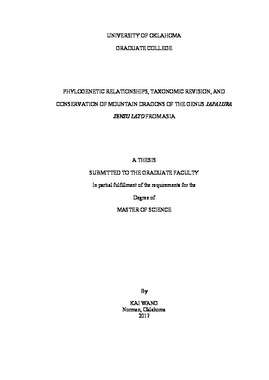| dc.description.abstract | Mountain Dragons of the genus Japalura sensu lato (sensu lato means “in the broad sense”) are small-to-medium sized, insectivore lizards of the family Agamidae. Although similar to the Iguanaian lizards of the New World in external morphology, members of the genus Japalura sensu lato are found in Asia only, and have a distribution from eastern Pakistan along the Himalaya to Southwest China, and eventually reaching the Okinawa islands of Japan. Being one of the most diverse genera in the family, the genus currently consists of 34 recognized species. Such a wide-distributional range across major geological features (e.g. the Himalaya, Tibetan Plateau, and East Asian island archipelagos) and high species diversity make Japalura sensu lato a great potential system for evolutionary and biogeographic studies.
However, despite such great potential as a study system, little research has been done on the group, mostly due to its problematic and unresolved taxonomy. Although the genus sensu lato has long been recognized as paraphyletic based on limited genetic sampling, its taxonomy has not been revised, and phylogenetic relationships among the majority of congeners remain unknown. In addition, species diversity in southwest China has continued to be underestimated, where cryptic diversities are overlooked, resulting in a large species complex. Lastly, with the current problematic taxonomy, most congeners lack accurate conservation assessments, despite the great conservation threats that they face from landscape changes and habitat destruction.
For my first chapter, I utilize a densely sampled data set of both multilocus genetic and morphological data to provide the first phylogenetic inference of relationships among Japalura sensu lato species. My results show that members of Japalura sensu lato are polyphyletic, consisting of four major clades that are scattered across the phylogeny of the subfamily Draconinae. To address the widespread paraphyly of Japalura sensu lato and to stabilize the taxonomy within the family Draconinae, we revise the current taxonomy and split Japalura sensu lato into four genera, including two recognized generic names, Japalura sensu stricto and Pseudocalotes, one resurrected nomenclature, Diploderma, and one new genus. Following our revised taxonomy, we provided morphological diagnostic keys to all species of each of the four genera from Japalura sensu lato, and we discussed phylogenetic relationships, taxonomy at both generic and species levels, and the general biogeography of Japalura sensu lato.
For my second chapter, I focus on the East Asian clade of Japalura sensu lato, which is the genus Diploderma after my taxonomic revision, and I investigate the species level diversity of the genus in Southwest China, particularly along the rich fluvial systems of the Hengduan Mountain Region, east of the Tibetan Plateau. Despite being recognized as ecologically and biogeographically important, the biodiversity of the Hengduan Mountain Region, particularly along the upper Mekong and Yangtze River, remains poorly understood. Using morphological evidence, I describe three new species of Mountain Dragon in the genus Diploderma from the upper reaches of the Mekong and Yangtze Rivers in Tibet Autonomous Region, Sichuan Province, and Yunnan Province of China. These species are recognized as members of the Diploderma flaviceps (Barbour & Dunn 1919) complex, but they can be distinguished readily from all congeners by a suite of distinct morphological characteristics. In addition to the descriptions of new species, I also report morphological variations and range extensions of three recently described congeners, namely D. batangense, D. iadinum, and D. vela. I discussed the distribution patterns of the genus and the urgent conservation priorities for protecting Diploderma species in the Hengduan Mountain Region. According to the best available population and habitat data from my field surveys, I provide IUCN assessments for all recognized species of the genus in the Hengduan Mountain Region and propose listings of all congeners as nationally protected under the Chinese Wildlife Protection Act. | en_US |
